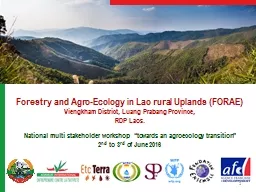

Viengkham District Luang Prabang Province RDP Laos National multi stakeholder workshop towards an agroecology transition 2 nd to 3 rd of June 2016 1 Limiting pressure on environment ID: 555261
Download Presentation The PPT/PDF document "Forestry and Agro-Ecology in Lao rural U..." is the property of its rightful owner. Permission is granted to download and print the materials on this web site for personal, non-commercial use only, and to display it on your personal computer provided you do not modify the materials and that you retain all copyright notices contained in the materials. By downloading content from our website, you accept the terms of this agreement.
Slide1
Forestry and Agro-Ecology in Lao rural Uplands (FORAE)
Viengkham
District,
Luang
Prabang Province, RDP Laos.National multi stakeholder workshop “towards an agroecology transition”2nd to 3rd of June 2016
1Slide2
Limiting pressure on environment,
Sustainable management of natural resources
Creation of incomes
Improvement of
agricultural productivity
Reduction of production expenses
Promotion of local knowledge/know-how
Food security and improvement of nutrition
Social and socio-professional organization enhancement
Agro-ecology in brief…
Agro-ecology
is a systemic approach
to agriculture, taking into account the economics of farms, but also environmental and social impacts of their activities, in order to insure their sustainability.
2Slide3
Agro-ecology in family farms…
When promoting
Agro-ecology
as a sustainable model of agriculture for family farming, we have to analyze how the farm is connected to its environment in order to propose adapted solutions to specific problems.
3Slide4
Rotational crops on slopes
Roaming animals in the village and the fallows
Problematics
:
Erosion and low soil fertility
Poor livestock management
Decrease of water quantity and quality
Food insecurity
Decreasing
forest cover
Crop association and improved fallow
Soil fertility and yield improvement
Green fence
Protect the soil against erosion and crop against roaming animals
Livestock pasture
Improve big livestock nutrition and health
Fruit trees plantation
Food diversification and income generating activity
Home gardening
Food diversification and income generating activity
Reforestation and NTFP domestication
Protection of natural resources (soil, water, biodiversity)
Income generating activity
Expected results
:
Land-use planning
Protection of natural resources
Improvement of family incomes
Improvement of family food security
Climate-change mitigation
Low access to clean water
Malnutrition and low food diversity
For example, in
Viengkham
District…
4Slide5
Food crops
Agro-ecology practices
:
C
over crops with
r
ice bean
Intercropping of leguminous with food crops (peanut, soy bean)
Green fence
5
Expected results:
Improvement of soil fertility
Decrease of soil erosion and soil
losses
Protection against roaming
animals
Crop
diversification and better nutrition
Additional sources of incomes
Challenges:
A
dditional
labour
work for leguminous
seeding
and harvesting
Roaming animals destroying leguminous
crops
Vulnerable to rats and lack of
water
Need
new
market opportunities for leguminousSlide6
Animal fodder
Agro-ecology practices:
Animal
pasture
at
village
scale
Green strips on
contour
lines
with
nepia
and guinea grasses
G
reen fence
6
Expected results:
Animal
control and
Health improvement
Soil protection against
erosion
Village Land Use
Planning implementation
Improvement of family incomes
Challenges:
High costs for fencing (
labour
and materiel
)
Lack of motivation to create collective pasture area (prefer individual
)
Low access to inputs, such as fodder seeds and barbwiresSlide7
Vegetable gardening
Expected results:
Crop diversification and better nutrition
Additional sources of incomes
Agro-ecology practices:
Production
of organic fertilizers
Water-saving
techniques: bowl farming and mulching
Crop associations
Integrated pest management: production of bio-pesticides, repellent plants
...
Off-season production: raised nursery
7
Challenges:
Lack of water for
irrigation
Lack of manure for fertilization (roaming animals
)
Lack of space for gardening within the village areaSlide8
Agro-Forestry
Agro-ecology practices
:
Plantation of fruit trees
Fruit tree orchards following contour linesNTFP domesticationMaintenance: Bamboo fence, biopesticides, mulching, cutting….
8
Expected results:
Crop
diversification and better
nutrition
Additional sources of
incomes
Protection
of vegetal
biodiversity
and forest cover
Challenges:
Lack of maintenance on fruit trees (low fertilization and weeding)
Additional
labour
work to install the contour
lines
High mortality on transplanted wild
stock (rattan)
Difficulty to protect NTFP against roaming
animals
Long-term investment for farmers before generating incomesSlide9
ຂອບໃຈ
ມີຄຳຖາມບໍ່?